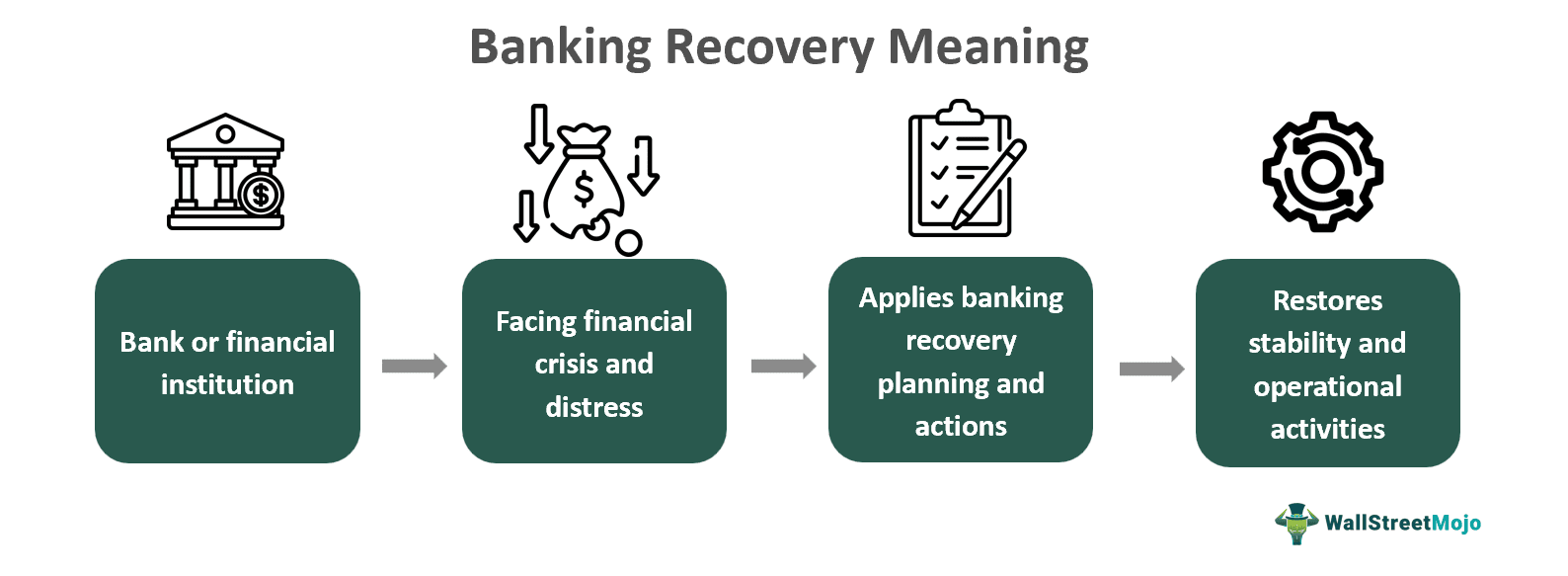Table Of Contents
What Is Banking Recovery?
Banking recovery is the blueprint drafted by banks to follow as a plan. Every bank, irrespective of its size, must have a banking recovery plan prepared to handle situations and survive the period of facing financial crisis and distress. Hence, a bank recovery is a set of rules and a plan of action that saves the banking system from collapsing.

Most commonly, the banks retain their position either by liquidation of their assets or incurring capital losses. In both scenarios, the main objective of a bank is to save itself in the harsh periods of recession, economic slowdown and depression. At the same time, the banking recovery allows them to restore control, authority and stability.
Key Takeaways
- Banking recovery is the list of options and well-thought-out scenarios by banks that they will initiate, face and execute in a situation of financial crisis.
- The inception of banking recovery goes back to the financial crisis of 2008 when multiple banks and financial institutions failed, and it highlighted the fragility of the banking system.
- Its process includes governance, documentation, integration, scope, critical functions, scenarios, triggers, recovery options, testing and communication.
- Although there can be many options available for a bank, the two important actions in banking recovery are asset liquidation and incurring capital losses.
Banking Recovery Explained
Banking recovery is defined as the set of rules and action plans that a bank has prepared for itself with proper planning, implementation, documentation and well-thought-out structure to employ in case it goes through financial distress or is facing a recession, economic slowdown or financial crisis due to internal or external events. The banking recovery is observed as a handbook with complete knowledge, access, options and actions that a bank can take in tough situations to deal with an economic crisis. It helps banks to remain active, ensure smooth functioning and avert any form of financial loss, or bank run scenario.
The history of banking recovery goes back to 2008, when the US housing stock market crashed and brought the entire global financial system to a stop. It was a key turning point for banks, which specifically highlighted the failures, errors, problems and fragility of the entire banking system. It proved that banks did not have enough rules and regulations present to sustain them in tough times.
Banks must create a recovery mechanism and account for all types of scenarios to make sure they have a range of recovery options available at their disposal to help them fight and revive from these shocks. Banks are obligated to share their recovery plans with supervisors and monitoring authorities. The European banking supervision receives plans from across all the areas and it enables them to benchmark and introduce best banking practices.
The Hargreaves Lansdown provides access to a range of investment products and services for UK investors.
Process
The process of banking recovery is as follows -
- Governance - The bank owns its recovery plan. The higher authority holds the resolution. The plan needs to be approved by the bank’s board and the executive management is responsible for its creation and testing.
- Documentation - The banking recovery plan and action are supported by good documentation and heavy paperwork, including important data and managerial information.
- Integration - The recovery plan should be well connected and integrated into different levels of the bank, addressing factors such as risk management, capital funding, testing approaches, strategic management, data aggregation and reporting.
- Scope - The plan must cover all parts, departments and groups connected to the bank. Hence, a wide scope of recovery and action must be taken.
- Critical functions - The banking recovery book must contain all types of critical functions that are available and can be taken at the time of crisis.
- Scenarios - After functions, the banking recovery must be very particular about all types of crisis scenarios that can happen. No matter how unusual it may sound, all scenarios must be covered.
- Triggers - These are essential in every banking scenario; these are well-prepared triggers that alarm the bank management, giving early warning and potential signs of foreseeable crisis by highlighting certain aspects. This way, banks can have control and take action in time. It includes asset quality, loss of key staff, macroeconomic indicators, profitability, capital, internal forecasts, liquidity and funding.
- Recovery options - Just like scenarios, the bank must think and draft all the recovery options that are within control, relevant and most importantly, doable without making many changes and are the best possible strategies.
- Testing and updating - Not all options can be tested, but it is a part of the banking recovery process. It must be verified to the maximum extent possible. It shall include scenario and simulation-type exercises.
- Communication - This is the last yet most important part of the process, the plan must be well communicated both internally and externally and keep the supervisors and other board members informed, especially when it is activated.
Examples
Below are two examples of banking recovery -
Example #1
Suppose a local bank in a small town. Due to the pandemic, there has been a huge economic slowdown in the whole market and the nation’s economy. There are no deposits, but huge withdrawals are happening. The stock market has also declined, and no investment options are left. In such a situation, the bank pulls out its banking recovery action plan to check on all the options available and relevant planning. The bank submits it to the appropriate authorities for review and approval.
The bank finds that instead of incurring capital losses, it is best to opt for liquidity. The bank, under the supervision of banking authorities, makes strong liquidity decisions and ensures the bank operations are active, and they avert the scenario of a bank run. Now, it is a straightforward example of banking recovery. However, in the real world, many direct and indirect factors affect the banking system, and management has to make strong and informed decisions to ensure safety and survival.
Example #2
In the second example, Bill Gross shows huge confidence in the potential recovery of the regional banking sector. He has invested in stocks that are linked to the SPDR S&P Regional Banking ETF along with First Horizon Corp., Trust Financial Corp., and Citizens Financial Group Inc. through an exchange-traded fund. Bill Gross believes that all these banks are at their lowest point and recognizes the long-term value of regional banks.
His position also indicates the optimism among other investors. However, there have been many concerning issues and problems like the collapse of Silicon Valley in March and the KRE fund facing problems within the banking sector. Bill Gross believes in the potential banking recovery of the whole sector. Bill Gross is an American fund manager and investor prominently known for co-founding Pacific Investments Management Company.
Importance
The importance of banking recovery is -
- Banking recovery is banking handbooks that comprise all the options and actions that are available and can be taken to restore the bank’s financial position and stability.
- Post global financial crisis of 2008, the banking recovery plans became a top concern and matter of high priority.
- Without a banking recovery plan, the banks would be lost with no idea how to revive themselves and collapse, bringing a lot of people and funds to the ground.
- Banks create this recovery plan and keep it to themselves only to submit it to the proper authorities for review and information.
Disclosure: This article contains affiliate links. If you sign up through these links, we may earn a small commission at no extra cost to you.

